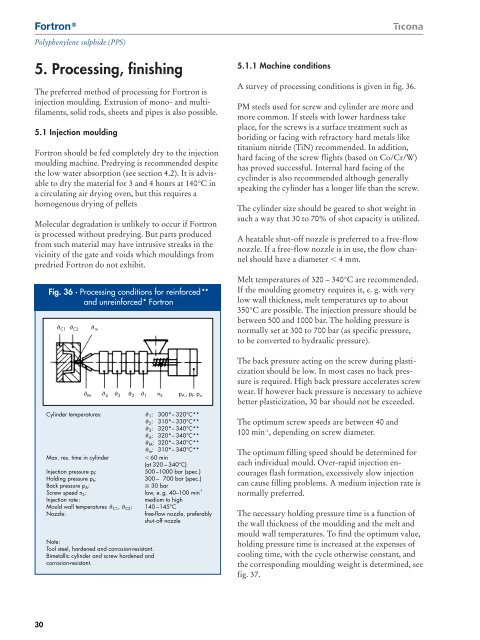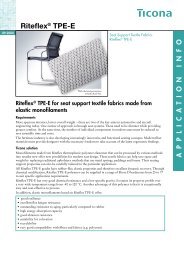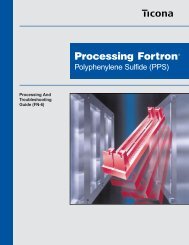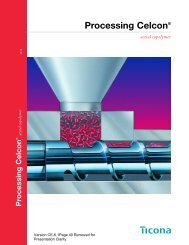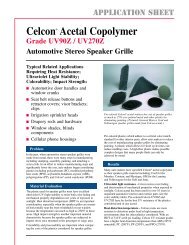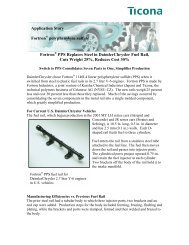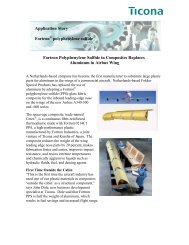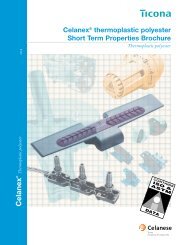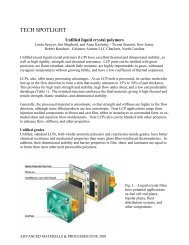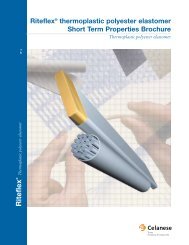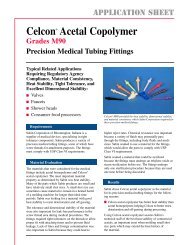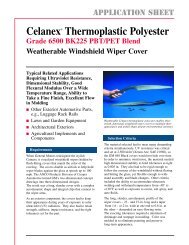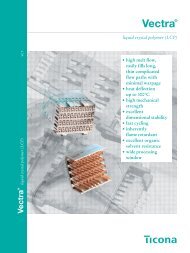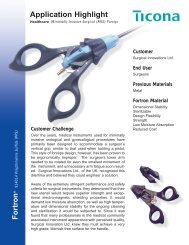Fortron PPS Product Brochure (B240) - Hi Polymers
Fortron PPS Product Brochure (B240) - Hi Polymers
Fortron PPS Product Brochure (B240) - Hi Polymers
Create successful ePaper yourself
Turn your PDF publications into a flip-book with our unique Google optimized e-Paper software.
<strong>Fortron</strong> ®<br />
Polyphenylene sulphide (<strong>PPS</strong>)<br />
5. Processing, finishing<br />
The preferred method of processing for <strong>Fortron</strong> is<br />
injection moulding. Extrusion of mono- and multifilaments,<br />
solid rods, sheets and pipes is also possible.<br />
5.1 Injection moulding<br />
<strong>Fortron</strong> should be fed completely dry to the injection<br />
moulding machine. Predrying is recommended despite<br />
the low water absorption (see section 4.2). It is advisable<br />
to dry the material for 3 and 4 hours at 140°C in<br />
a circulating air drying oven, but this requires a<br />
homogenous drying of pellets<br />
Molecular degradation is unlikely to occur if <strong>Fortron</strong><br />
is processed without predrying. But parts produced<br />
from such material may have intrusive streaks in the<br />
vicinity of the gate and voids which mouldings from<br />
predried <strong>Fortron</strong> do not exhibit.<br />
Fig. 36 · Processing conditions for reinforced**<br />
and unreinforced* <strong>Fortron</strong><br />
C1 C2 m<br />
M 4 3 2 1 n S p A ,p f ,p n<br />
Cylinder temperatures: 1 : 300*– 320°C**<br />
2 : 310*– 330°C**<br />
3 : 320*– 340°C**<br />
4 : 320*– 340°C**<br />
M : 320*– 340°C**<br />
m : 310*– 340°C**<br />
Max. res. time in cylinder<br />
60 min<br />
(at 320 – 340°C)<br />
Injection pressure p f :<br />
500 –1000 bar (spec.)<br />
Holding pressure p h :<br />
300 – 700 bar (spec.)<br />
Back pressure p A :<br />
30 bar<br />
Screw speed n S : low, e. g. 40–100 min -1<br />
Injection rate:<br />
medium to high<br />
Mould wall temperatures C1 , C2 : 140 –145°C<br />
Nozzle:<br />
free-flow nozzle, preferably<br />
shut-off nozzle<br />
Note:<br />
Tool steel, hardened and corrosion-resistant.<br />
Bimetallic cylinder and screw hardened and<br />
corrosion-resistant.<br />
5.1.1 Machine conditions<br />
A survey of processing conditions is given in fig. 36.<br />
PM steels used for screw and cylinder are more and<br />
more common. If steels with lower hardness take<br />
place, for the screws is a surface treatment such as<br />
boriding or facing with refractory hard metals like<br />
titanium nitride (TiN) recommended. In addition,<br />
hard facing of the screw flights (based on Co/Cr/W)<br />
has proved successful. Internal hard facing of the<br />
cyclinder is also recommended although generally<br />
speaking the cylinder has a longer life than the screw.<br />
The cylinder size should be geared to shot weight in<br />
such a way that 30 to 70% of shot capacity is utilized.<br />
A heatable shut-off nozzle is preferred to a free-flow<br />
nozzle. If a free-flow nozzle is in use, the flow channel<br />
should have a diameter 4 mm.<br />
Melt temperatures of 320 – 340°C are recommended.<br />
If the moulding geometry requires it, e. g. with very<br />
low wall thickness, melt temperatures up to about<br />
350°C are possible. The injection pressure should be<br />
between 500 and 1000 bar. The holding pressure is<br />
normally set at 300 to 700 bar (as specific pressure,<br />
to be converted to hydraulic pressure).<br />
The back pressure acting on the screw during plasticization<br />
should be low. In most cases no back pressure<br />
is required. <strong>Hi</strong>gh back pressure accelerates screw<br />
wear. If however back pressure is necessary to achieve<br />
better plasticization, 30 bar should not be exceeded.<br />
The optimum screw speeds are between 40 and<br />
100 min –1 , depending on screw diameter.<br />
The optimum filling speed should be determined for<br />
each individual mould. Over-rapid injection encourages<br />
flash formation, excessively slow injection<br />
can cause filling problems. A medium injection rate is<br />
normally preferred.<br />
The necessary holding pressure time is a function of<br />
the wall thickness of the moulding and the melt and<br />
mould wall temperatures. To find the optimum value,<br />
holding pressure time is increased at the expenses of<br />
cooling time, with the cycle otherwise constant, and<br />
the corresponding moulding weight is determined, see<br />
fig. 37.<br />
30


